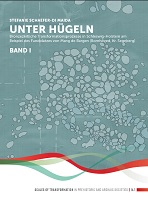Unter Hügeln
Bronzezeitliche Transformationsprozesse in Schleswig-Holstein am Beispiel des Fundplatzes von Mang de Bargen (Bornhöved, Kr. Segeberg) BAND 1
| dc.contributor.author | Schaefer-Di Maida, Stefanie | |
| dc.date.accessioned | 2023-05-23T11:50:13Z | |
| dc.date.available | 2023-05-23T11:50:13Z | |
| dc.date.issued | 2023 | |
| dc.identifier.uri | https://library.oapen.org/handle/20.500.12657/63061 | |
| dc.description.abstract | During the Bronze Age the new, eponymous, highly-desired metal spread widely across Europe. It changed labour sectors, networks, worldviews and societies, and brought with it different transformations in diverse areas of life and death. With this book, all changes from the Bronze Age for the area of Schleswig-Holstein were put under the spotlight. In this framework of research, the Mang de Bargen site near Bornhöved (district of Segeberg), once the target of gravel works, developed into one of the best-dated Bronze Age sites in Schleswig-Holstein. The cemetery was used from the Late Neolithic to the Pre-Roman Iron Age as a burial site. During this long period of use, several cultural changes, including burial rites, grave furnishings, and further activities, can be traced. The rigorous dating of almost all of the graves allows, in particular, the precise identification of the moment of transition from inhumation to cremation, as well as the shift from burial mounds with log coffins to the beginning of the use of urns in northern Germany. Anthropological analyses of the cremations from Mang de Bargen and other sites in the area also reveal the age-related placement and furnishings, which might in turn stimulate new discussions. A comparison with environmental data (archaeobotany and palynology) also shows the scope of human impact in comparison to the archaeological investigations. The inclusion of data on graves, hoards, and settlements for the whole of Schleswig-Holstein enables this fully-investigated cemetery to be contextually embedded, and shows how — and how differently — transformation processes manifested themselves at local, regional, and supra-regional levels. Volume 1 comprises the main text, the feature catalogue, the site plans, the main site profiles, the results of the radiometric dating and the interim results of the preliminary anthropological investigations. Volume 2 comprises the plates, as well as the following external reports: the anthropological report (Storch), the archaeobotanical study (Filipović) and the palaeoecological study on the site (Feeser). | en_US |
| dc.language | German | en_US |
| dc.relation.ispartofseries | Scales of Transformation | en_US |
| dc.subject.classification | thema EDItEUR::N History and Archaeology::NK Archaeology::NKD Archaeology by period / region | en_US |
| dc.subject.classification | thema EDItEUR::3 Time period qualifiers::3B Prehistory | en_US |
| dc.subject.other | bronze age; northern Germany; funerary archaeology; chronology; burial rites; barrows; urnfields; radiocarbon dating; anthropology; palynology; archaeobotany | en_US |
| dc.title | Unter Hügeln | en_US |
| dc.title.alternative | Bronzezeitliche Transformationsprozesse in Schleswig-Holstein am Beispiel des Fundplatzes von Mang de Bargen (Bornhöved, Kr. Segeberg) BAND 1 | en_US |
| dc.type | book | |
| oapen.relation.isPublishedBy | 471fd6d5-f295-4fd0-a13a-e60a6420f603 | en_US |
| oapen.relation.isFundedBy | 631ac483-8bae-460f-9987-c3f4e4b98bb5 | en_US |
| oapen.relation.isbn | 9789464280487 | en_US |
| oapen.relation.isbn | 9789464280494 | en_US |
| oapen.imprint | Sidestone Press Dissertations | en_US |
| oapen.series.number | 16,1 | en_US |
| oapen.pages | 540 | en_US |
| oapen.place.publication | Leiden | en_US |
| oapen.grant.number | 2901391021 – SFB 1266 | |
| oapen.grant.program | DFG | |
| oapen.grant.project | Collaborative Research Centre 1266 |

